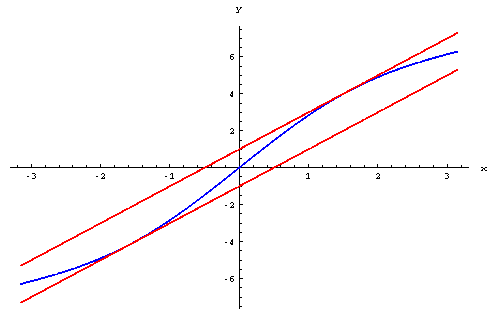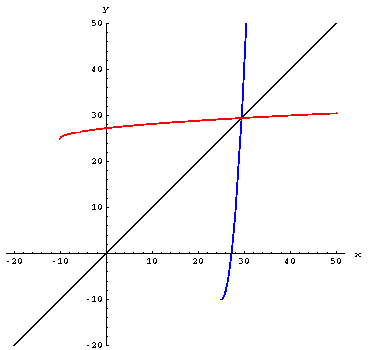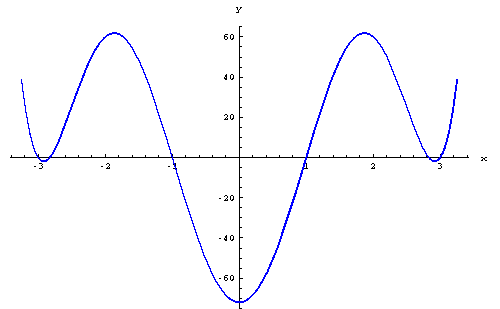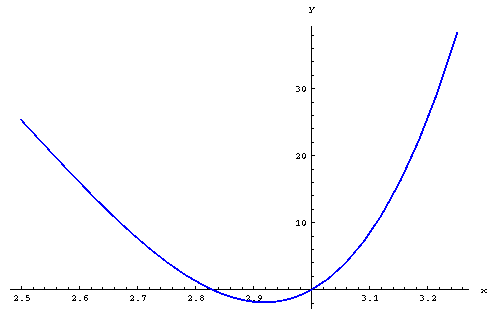- Amplitude
Answer: 5. - Period
Answer:
- Horizontal Shift(phase shift)
Answer: 2 to the right. - Vertical Shift
Answer: 10 down. - Domain
Answer: The domain is the set of all real numbers, or in interval notation, .
.
- Range
Answer: The range is the set of all values of , or in
interval notation, [-15,-5].
, or in
interval notation, [-15,-5].
- and four points that have a y-coordinate of -15.
Answer: Here are such four points that have a y-coordinate of -15:

 is located on the
terminal side of the angle t, find a point on the terminal side of
the following angles:
is located on the
terminal side of the angle t, find a point on the terminal side of
the following angles:
-

Answer: .
.
-

Answer: .
.
-

Answer: .
.
- -t
Answer: .
.
 as an algebraic expression in x.
as an algebraic expression in x.
Answer:

- Convert
 to radian measure.
to radian measure.
Answer: 2.6269 radians. - Convert 150.3040 radians to degree measure in the
 format.
format.
Answer:
- The graph of
 is bounded by what two lines?
is bounded by what two lines?
Answer: The graph of f(x) is bounded by the lines y=2x+1, and y=2x-1. - Why are these two lines considered boundary lines?
Answer: Because the biggest value can attain is 1, and
the lowest value it can attain is -1, the graph of the function
can attain is 1, and
the lowest value it can attain is -1, the graph of the function
 is caught between the two boundary lines.
is caught between the two boundary lines.
- Graph the function and the two boundary lines.
Answer:
Answer: The buildings are approximately 6,928 feet apart.
- Restrict the domain of the function
 to an
interval where the function is increasing, and
to an
interval where the function is increasing, and
Answer: The biggest interval which will work is .
.
- Determine
 over that interval.
over that interval.
Answer:
- Then sketch the graphs of both f and
 on the same
coordinate system.
on the same
coordinate system.
Answer:
- What relationship do the graphs of these two functions have to
the graph of the function g(x)=x?
Answer: The graph of is a reflection of the graph of f(x)
about the line g(x).
is a reflection of the graph of f(x)
about the line g(x).
Answer: The interest earned after 10 years will be $57,509.67.
![]()
Answer: The inequality will be always true except when x=2,
and x=-2.
- When does
 ?
?
Answer: They are equal only when x>0. - When does
 ?
?
Answer: They are equal only when x>0.
- In what year was the population 60,000?
Answer: It was 60,000 in the year 1935 with 9 months. - Did the population ever reach 100? If yes, when? If no, why
not?
Answer: It will only reach 100 in the year 2078. - How long will it take for the population to reach 1,000,000?
Answer: The population can never increase as long as the same decreasing behavior continues.
![]()
- Algebraically
Answer: There are six zeros. Use the rational zero test and synthetic division to find the 4 rational zeros:
The remaining zeros
 can be found with the quadratic formula.
can be found with the quadratic formula.
- Graphically. Explain how you interpreted the graph to arrive at
your answer.
Answer: The graph below tells us that there are zeros at , and 4 more roots close to x=3.
, and 4 more roots close to x=3.



Answer:
 .
.